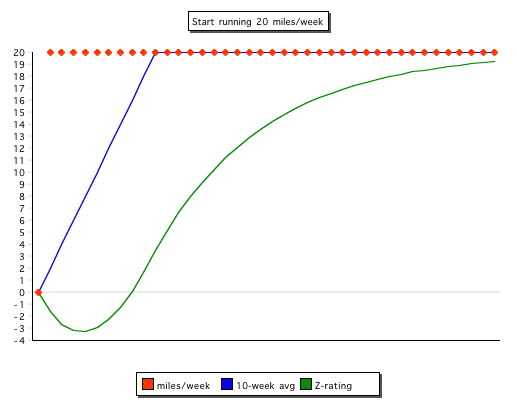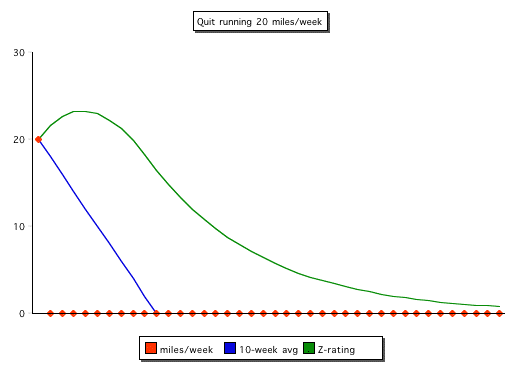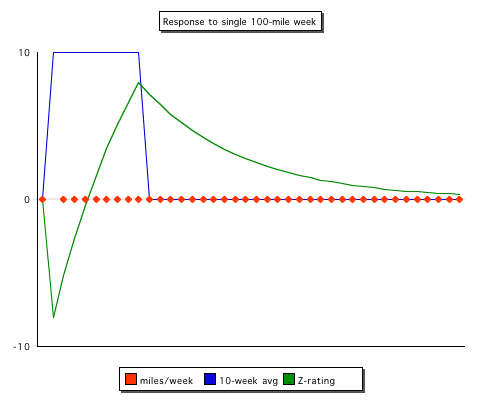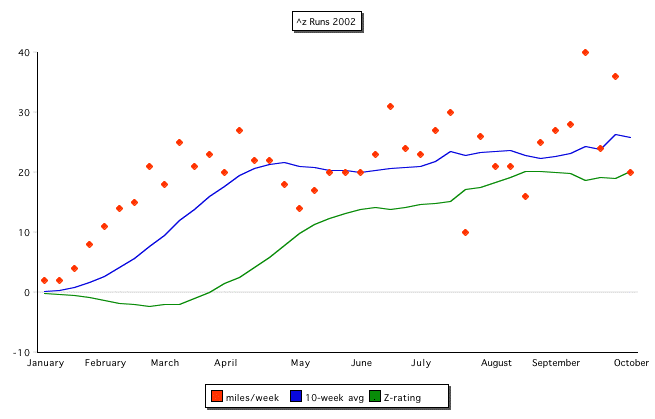Runners are often slaves to their logbooks, and I'm no exception. Though I try to behave rationally, guilt feelings well up inside when I see the end of a week approaching and my mileage total is less than I have hoped for. Sure, I'm injured, sick, busy; the temperature is insanely high, as is the humidity; the air quality is infernal. But no matter — I've gotta get out there and hammer out some distance, so I can write it into the log. Stupid, eh?!
What's needed? A model: something to replace simple-minded total miles, and provide a better measure of fitness and progress toward one's goals.
Taking a moving average over many days or weeks is a good start, but it's not enough. A rest day of no running knocks the average abruptly down; conversely, when a low day (or week, or month) moves out of the averaging window the curve suddenly jumps up. The resulting graph is noisy and less useful than it could be. See the 7-day and 30-day lines in JogLogFog2 (10 Oct 2002), for example. Filtering out the jigglies from such charts would make them look smoother, but would also make the calculations complex without significant analytic value-added.
The right approach begins with some simple real-world knowledge about how exercise affects the body. Among the major truisms to consider:
- general physical fitness takes many weeks to build up
- contrariwise, fitness declines slowly when one doesn't work out
- the immediate effect of an abrupt increase in exercise is damage (or even injury), which takes time to heal
- the long-term effect of increased exercise is improved strength and speed
- rest (or at least tapering off) is beneficial before a major competition
These common observations suggest that a good running fitness measure should:
- rise (or fall) slowly, over a period of many weeks, as distances increase (or decrease)
- penalize a sudden jump in distance run
- reward a reduction in distance before a race
- be easy to compute
Putting these principles together, I've come up with what I not-so-modestly call the Z-rating — a weighted moving average that's (relatively) straightforward to reckon by hand (and trivial to do on a spreadsheet). The basic formula is:
| (New Z-rating) = 0.9*(Previous Z-rating) + 0.2*(10-week average) - 0.1*(last week's miles) |
For the non-algebraic-minded, what this equation says is that once you're in shape, you generally stay that way for a few months (the 0.9 and 0.2 multipliers and the 10-week average) but that an abrupt increase in workload will tend to knock you down for a week or so (the -0.1 multiplier). On the other hand, taking it easy for a few weeks will push your Z-rating up, as damage heals and energy stores build. So the Z-rating formula fits nicely with the commonsense practice of "tapering" before a big race. (To start a computation, begin with Z-rating equal to a long-term average miles run per week. The starting value you assume for "previous Z-rating" won't matter after a few months.)
But better than abstract symbols, here are some pictures of how the Z-rating works in a few simple sample situations. Begin with a hypothetical person who has never exercised but who abruptly (and foolishly) starts doing a constant 20 miles per week.

As you can see the Z-rating goes negative at first (muscle soreness, joint pain, depletion of energy resources, etc.) — this person is hurting! But after a few weeks the Z-rating begins to move up, goes positive, and eventually asymptotes to the weekly mileage of 20. (The 10-week moving average ramps up steadily for the first ten weeks, of course, until it reaches 20 where it suddenly levels off.)
In contrast, for a person who has been steadily running 20 miles per week and suddenly quits, the effect is precisely the opposite:

The Z-rating begins at 20 miles/week and initially improves. It's actually better than its pre-quitting baseline value for 7 weeks or so ... but then the loss of fitness starts to dominate and it decays exponentially toward 0. Hence, the short-term benefit of "tapering". (This curve is actually the same as that for the previous case, just turned upside down and shifted up by 20, as it should be theoretically.)
If you are an electrical engineer and want to see the response to a transient spike (is this the so-called "Z-transform"? — I don't know) here is the result for an off-the-vertical-scale 100 mile week that is surrounded by infinite weeks of no running:

The 10-week moving average is 0 before the 100-mile week, and it's 10 miles/week for a window of 10 weeks following that wild week, after which it reverts to 0. As expected, this hypothetical ultra-person has some severe damage for a few weeks, then recovers to a modest positive rating before the decay back to zero commences. (The peak value turns out to be ~8 miles/week, and it occurs ~8 weeks after the Big Week — but I strongly recommend against taking those specific values seriously.)
Finally, some real data — my own much-more-random running log of weekly miles for the first nine months of 2002:

My interpretation of this ugly picture:
- I ramped up (from ~2 miles/week to ~20 miles/week) much too fast back in January-March (the negative Z-rating zone)
- the moderate distance I did during the summer months was probably wise (esp. given the heat and bad air) since it gave the Z-rating time to creep up toward the 10-week moving average
- those big weeks back in September (when I did 40 miles and 36 miles respectively) have hurt me slightly but should be of benefit during weeks to come, assuming my knee hasn't been too badly damaged by over-enthusiasm of course
A Very Good Thing about the Z-rating formula is that it smooths out fluctuations that otherwise make the graphs jump around far too much. More importantly, when a "bad" spell happens (e.g., my late July 10 mile week) I don't have to worry quite so much ... since I can tell myself that (1) it will be absorbed by the moving average, (2) it is a chance to heal, and (3) it actually raises my Z-rating (for a few weeks anyway). Psychologically, that is extremely helpful. (In fact, if I were to stop running entirely right now, my Z-rating would move up over the next few weeks from ~20 to ~27 before it begins a steady decline back toward 0.)
What comes next after the Z-rating? A more general relationship along the same lines is:
| (New Z-rating) = x*(Previous Z-rating) + y*(N-week average) + z*(last M week's average) |
Note that x+y+z should equal 1, so that the Z-Rating comes out in properly normalized units of miles/week. My equation just sets the parameters to x=0.9, y=0.2, N=10, z=-0.1, and M=1. One might argue for an x value closer to 1 (slower decay of fitness), for a larger N (mileage averaging time), and for a smaller z (damage from overwork). But I think that the defaults are probably in the right ballpark for most people, most of the time.
Other factors should, arguably, be folded into a super-Z-rating:
- temperature
- humidity
- hills
- health
- speed
- ...
Maybe some day!
(see RichardsonianExtrapolation (18 Apr 2002), JogLogFog (9 Jun 2002), JogLogFog2 (10 Oct 2002), ...)
TopicRunning - TopicScience - TopicPersonalHistory - 2002-10-17
This is a nice idea, but is it really true that when you stop exercising your fitness increases? This seems counter-intuitive. - Andrew Duffin
Tnx for your comments, Andrew. The phenomenon seems counter-intuitive, but apparently it's true, at least some (much?) of the time for some (many?) people. Hence, the custom of "tapering" for ~3 weeks before a big race, according to experienced runners whom I've talked with and books which I've read. My own symptoms (e.g., constant soreness) during the months during & after I ramped up my mileage too steeply (see above) correlate. And in theory, there's some sense to it — since hard exercise depletes glycogen and other energy stores, as well as causes damage (micro-tearing or worse?) to muscle tissue and joints.
The big questions remain, of course: (1) What's the magnitude of the effect?; and (2) How long does it persist before the positive training effect increases strength?
I don't know any answers, though the time and magnitude constants in my tentative Z-factor formula seem not too far out of the ballpark .... ^z
(correlates: FlashInThePan, JogLogFog2, FascinatingVersusInteresting, ...)